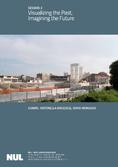local development scali ferroviari revelation public art premio tesi di laurea economics dottorati city architecture giornata di studi inu European policies urban development ecological networks cartography heritage populations urban policies transport & logistics educational strategic planning superplaces public policies neighborhood maps rigenerazione urbana
Conference Proceedings NUL | NEW URBAN LANGUAGES Session 2 | Visualizing the Past, Imagining the Future
Try to interpret the urban phenomenon means, first of all, facing with the times of the past and projections of the future.
The everyday life in the city has to deal with continuous reconstructions and stories of the urban past as much as with imaginary and scenarios of many possible times to come: the future of the expected changes, the future of urban decline, the future of the loss of identity in the large metropolitan regions.
Visions and imaginary thus become indispensable tools for connecting the course of fragmented time inside cities. Quoting Jude Bloomfield we can say that: “The memory, history and identity of a city are not the emanation of an enclosed, hermetically sealed, ‘pure group’ and their past, but the ongoing social construction of people with diverse histories whose lives intersect a specific place. Therefore the urban imaginary is also inherently intercultural but located, cosmopolitan but rooted”
LIST OF CONTENTS | SESSION 2
VISUALIZING THE PAST, IMAGINING THE FUTURE
Chairs: Antonella Bruzzese, Sofia Morgado
• Territorial branding strategies behind and beyond visions of urbanity. The role of the Fuorisalone event in Milan
Antonella Bruzzese, Claudia Botti, Ilaria Giuliani
• Railway station and urban transition in China
Zhen Chen
• Memory of the space. A cognitive way of thinking
G.M.A. Balayet Hossain
• Urban transformations. The ghetto of Rome in the sixteenth century to the early twentieth century
Elisabetta Liumbruno
• The retro-active effect of the cyberspace on physical space: the iper-dense city
Debora Magri
• The Fluvial City: change and representation. Case of Dora Riparia
Natalia Kudriavtseva
• Historical - virtual reconstruction of an Italian garden. Imagining the past of Villa lo Zerbino
Anna Toth, Davide Spallazzo
• Chinese expression of the urban landscape. The contemporary spatial strategies of the traditional Chinese courtyard building
Tan Zhu
Download
- LIST OF CONTENTS | Session 2 | NUL Conference Proceedings
- 01 NUL Conference Bruzzese, Botti, Giuliani Session 2
- 02 NUL Conference Chen Session 2
- 03 NUL Conference Hossain Session 2
- 04 NUL Conference Liumbruno Session 2
- 05 NUL Conference Magri Session 2
- 06 NUL Conference Kudriavtseva Session 2
- 07 NUL Conference Toth, Spallazzo Session 2
- 08 NUL Conference Tan Session 2




Planum
The Journal of Urbanism
ISSN 1723-0993
owned by
Istituto Nazionale di Urbanistica
published by
Planum Association
ISSN 1723-0993 | Registered at Court of Rome 4/12/2001, num. 514/2001
Web site realized by ChannelWeb & Planum Association | Powered by BEdita 3

